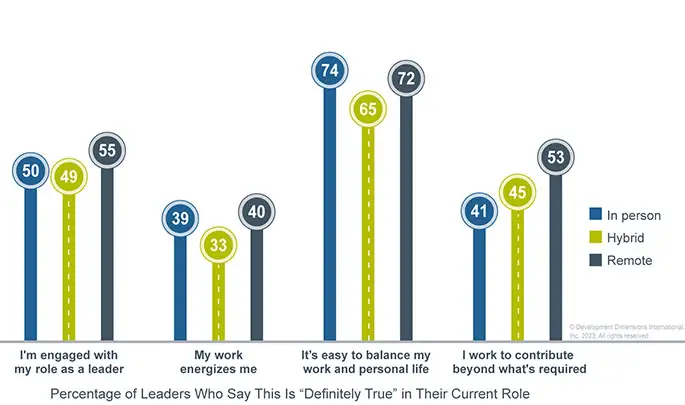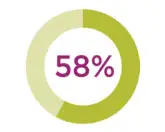GLOBAL LEADERSHIP FORECAST 2023
BY THE NUMBERS
Remote Leaders Report Highest Role Satisfaction

Rather Than a Perfect Compromise, Hybrid Work May Offer the Worst of Both Worlds
There’s a fast and furious experiment for companies trying to optimize the workplace for productivity and collaboration. As senior executives worry about loss of company culture and decreased teamwork, employees encounter resistance to flexible work arrangements.
Hybrid work culture is actually the most difficult and least engaging approach.
While there’s significant variation across countries and industries, many companies have attempted to compromise with hybrid work, hoping to offer flexibility while preserving the face-to-face culture of their organization. Surprisingly, our research shows that a hybrid work culture is actually the most difficult and least engaging approach.
When we asked leaders to rate the quality of their leadership and work experiences, leaders who work in hybrid roles reported the lowest ratings for how engaged and energized they are at work. Fewer than half (49%) of leaders working in a hybrid role reported being definitely engaged and only a third reported that their work energizes them, about 10% less than their in-person and remote counterparts.
One reason that hybrid leaders are least engaged seems to be that hybrid work combines the worst of both worlds and challenges leaders to maintain a difficult balance of priorities. Hybrid leaders were least likely to say that it’s easy to balance their work and personal lives. As leaders face the challenges of connecting with and leading dispersed teams, the additional burden of making and coordinating time in person with their teams is taking a toll.
WHERE TO FOCUS
Drive Engagement Through Key Leadership Behaviors
For hybrid and remote work to be successful, employees need to be engaged and productive. We examined leadership behaviors and found that four consistently stand out for driving higher levels of engagement:
- Maintains trust with employees.
- Encourages others to challenge old ways of doing things.
- Listens and responds with empathy (understanding others’ emotions).
- Provides opportunities for team members to gain visibility.
It’s important for leaders of hybrid and virtual teams to consider how much these behaviors can make a difference. In particular, trust and visibility make a huge difference for employees who are straddling an in-person and virtual work culture. Hybrid employees were 4.4X more engaged when their manager regularly maintained trust, and 4.6X more engaged when their manager provided team members with opportunities to gain visibility.
Hybrid employees were 4.4X more engaged when their manager regularly maintained trust.
For fully remote employees, receiving feedback was a top driver of engagement. Remote employees who reported that their manager regularly provided constructive feedback had engagement rates 2.5X higher than employees who did not receive feedback regularly.
The need for effective hybrid and virtual leadership will only grow as the youngest generations entering the workforce continue to desire and expect work flexibility. Leaders need support and development to improve their virtual leadership skills, especially given that only 27% say they are very effective at leading hybrid or virtual teams, making it leaders’ least-effective area overall.


